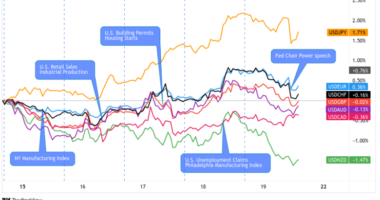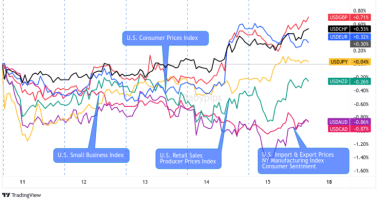Tomorrow at 12:30 am GMT Uncle Sam will publish its June NFP numbers.
What are markets expecting? More importantly, how can USD react to the releases?
Here are points you need to know:
What happened before?
- US adds 390K payrolls in May vs. 325K expected, 436K in April
- Unemployment rate unchanged at 3.6% vs. 3.5% expected
- Participation rate edged higher from 62.2% to 62.3%
- Average hourly earnings up by 0.3% vs. 0.4% expected
- April’s payrolls revised higher from 428K to 436K
The U.S. added a net of 390K jobs in May and marked the lowest increase since April 2021.
The labor force participation rate improved from 62.2% to 62.3%, which is probably why the unemployment rate stayed at 3.6% when analysts saw a dip to 3.5%.
Meanwhile, March’s numbers were revised (slightly) lower and April’s job additions were adjusted higher.
While the payroll figures registered at their lowest in a while, the overall labor market picture was still tight enough to support the Fed’s aggressive tightening schedule.
No wonder the dollar gained across the board back then! USD traded in tight ranges before the release and then shot higher and made new intraday highs against its counterparts until the end of the day.
What’s expected this time?
- June NFP to come in at 275K
- Unemployment rate seen steadying at 3.6%
- Average hourly earnings to grow by another 0.3%
- Participation rate to maintain at 62.3%
Markets expect the U.S. to add an additional 275K in June even as other reports are expected to maintain their May readings.
The participation rate is expected to remain at 62.3%, which should be enough to keep the unemployment rate at 6.3%. Average hourly earnings is also expected to maintain its 0.3% increase for the month.
Leading indicators aren’t much help with their mixed signals.
Markit’s services PMI noted a “sharp increase in employment” as service providers continued to raise their staffing levels. Meanwhile, ISM’s services PMI dipped into contraction territory (47.4) for the third time in the last five months thanks to businesses “unable to fill positions with qualified applicants.”
If June’s NFP reports paint only a slight slowdown in the job market, then the Fed will have more room to raise its interest rates and tighten its monetary policies.
USD could gain more pips against its counterparts and register new intraday highs like it did last month.
If we see downside surprises, though, then USD could get knocked down from its weekly highs. USD could lose pips especially against safe-havens like JPY and CHF.
If you’re planning on trading this top-tier event, make sure you check out the average volatility of USD pairs as a guide in setting stops and targets.
But if you’re not comfortable with potential price spikes, it’s totally okay to sit on the sidelines and watch price action unfold.









